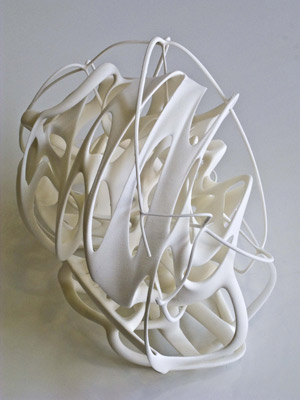Scalable Relations
UCSB's New Media Arts Faculty Show Conceptual Work
Some art is difficult to describe, like conceptual and performance art pieces that involve little physical craftsmanship, instead featuring theories and ideas. Yet even in their most minimal forms, conceptual art pieces tend to include some sort of construction. In Scalable Relations, a UC-wide series of exhibitions that feature digital artworks by New Media Arts faculty, including an actual art object is optional.
The exhibition is housed in the hallways and working labs of UCSB’s Elings Hall, home to the California NanoSystems Institute and the Allosphere Research Facility, and it features Media Arts and Technology (MAT) faculty member Marcos Novak and UCLA Design and Media Arts (DMA) professor Ruth West. The MAT and DMA programs have teamed up with researchers in engineering, chemistry, biology, and physics “to visualize and explore complex series of data that were previously only available in traditional computing forms.” It is at this juncture where Novak and West’s work materializes, in physical and virtual forms, to create cartographies of the invisible.

A virtual architect, Novak strives to turn abstract concepts-like space, music, and time-into navigable and tactile expressions. His installation, “Turbulent Typologies,” consists of photos projected on the gallery walls of sculptures designed by architectural algorithms. The results are dynamic sculptures with fluid arms twisting in and out in mimicry of the streaming data.
But it is in the transLAB where Novak’s work has its most striking effect: An abstract image is projected on each of the four walls, and a large tarp is spread out on the floor. At first glance, the room appears to be empty, but one wave of the infrared wand you’re handed at the door, and what previously was invisible suddenly appears. Each time the wand slices through space, it reveals a spherical sculpture at the center of the room, four feet tall, with a honeycomb structure. Visual and sound effects ripple out in response-blues and purples, low tones and high-pitched buzzings creating a multisensory experience.
West’s piece, “Atlas in Silico,” functions in a similar manner, using data from the Global Ocean Sampling Expedition to produce both interactive virtual atmospheres and individual objects rendered in the style of 19th-century naturalist illustrations.
Ultimately, the exhibition makes visible and tangible the abstract systems that run our modern lives, like the cell phone signals that bounce off satellites. Interconnectivity is more than a digital phenomenon, this show suggests; it’s a relevant tool for connecting the dots-invisible and visible-of everyday life.



